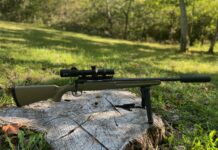EnGarde Body Armor sent us their “Patrol” model bullet-resistant vest to evaluate, so we sent it on to ShootingTheBull410 with specific instructions: “blow this thing up.” And it was with mixed emotions that he did so, because, on the one hand, this was a really nice vest. It’s a full Level IIIA vest, rated to stop a .44 Magnum. It’s well built, light, comfortable…it would be a keeper. On the other hand, hey — it’s fun blasting stuff to pieces. Check out the video to see how well it did when pitted against everything from a .22LR to a 12-gauge shotgun slug.




I am actually surprised the slug didn’t make it. Those have a whole pile of energy behind them.
I’ve worn a lot of different types of body armor and seen a lot of videos of body armor and I cannot recall a slug ever getting through, video-wise. I’ve seen people shot (and survive) with body armor, but I haven’t personally seen anybody wearing body armor and shot with a shotgun. Doesn’t mean they won’t leave a hurt, just that they won’t penetrate.
I was shot in the vest in Iraq. Turns out the dirtbag had loaded his SVD mags with straight API. My plate took the hit, but I still had a hairline fracture of my sternum and four dislocated/broken ribs. Getting shot sucks. Getting shot in body armor sucks only a little less. I wouldn’t try it at home.
I took what we thought was a 5.45×39 (didn’t get the gun or the Haji) on a plate. That was not a particularly fun experience for me either. I can only imagine what a 7.62x54R would feel like. Oww…
Little poodle-shooter rounds are peanuts compared to full-power rifles. That 7.62×54 R is pretty well ballistically identical to the .30-’06, and carries a lot more ass down range. I was hit from more than 300 meters away, and I swear I thought it went through after it knocked me straight onto my ass. I could probably compare it to getting punched by Mike Tyson in his prime, only with that all force focused on an area the size of a pen point.
My body armor (and helmet) survived a (relatively) small IED. Those things work. Of course it was the standard ESAPI plates backed with soft armor. However my eyepro, eyes, and face didn’t fare as well as the armor. I’ve still got tiny rocks in my body where the IOTV ends. Armor isnt just for bullets.
I’m not surprised. A slug has rather a lot of surface area. I’d wager that it really doesn’t need to though.
Yeah, the impact of that 12 ga slug would have taken you down. I can’t believe there would not have been internal injuries even tho the slug didn’t penetrate.
Still better than being hit with the slug and no vest.
Any idea what the street price is? Doesn’t say on their site.
Their US site says from 625 dollars, shipped.
http://www.usabodyarmor.com/tactical-body-armor.htm
Their US site says from 625, shipped.
usabodyarmordotcom/tactical-body-armor.htm
A slug would still send a hell of a shock wave through a body possibly breaking ribs and causing internal injuries that could incapacitate them. Thats a whole lot of energy to be absorbed
Some slugs are harder than others. Most will not penetrate IIIA. I would be surprised if perps ever use the kind that will. Handguns are the issue, and .454 Casull also does not appear in perps’ hands. Good to see the vest worked, though I have to assume those on patrol have (they should…) an over-vest with plates in the trunk.
I like this guy.
Remember those old PASGT vests from back in the 70s?
Those are remarkably bullet resistant themselves.
Here’s an article I did 10 years ago about one of those vests we sacrificed in the name of science.
From GunNews Magazine, September 2003 issue
Mayview, IL (GSL.com) – The U.S. Personal Armor System, Ground Troops protective vest was introduced to American troops in the early 1980’s. Constructed of Kevlar-29 fabric, it was designed and built to protect soldiers from fragmentation injuries. Today, these vests are being phased out with the adoption of the new and vastly superior Interceptor Body Armor system.
In all the available literature, these PASGT vests are reported to be ineffective against small arms fire. However, as the ballistic component was made of the famous, bullet-snaring Kevlar, we wanted to know if these vests, now available at surplus stores and by mail order for less than $50 apiece, would serve as poor-man’s body armor against pistol rounds.
We set up the test by placing the vest over two 30 pound bags of Yesterday’s News litter. We fired from about ten feet away and inspected the vest after each shot.
We began shooting the vests with rounds from 9mm caliber and worked our way up to .44 Magnum. The only round the vest was unable to defeat was a 9mm Federal 115gr. FMJ round. While it passed through the vest, it had very little remaining energy and didn’t even pass through the first bag of litter. When we backed up to 15 yards, the vest stopped the 9mm FMJ round.
To summarize, the vest stopped the hollowpoint bullets cold, even the venerable .44 Magnum. Round-nosed slugs presented more difficulty, but the vest caught these rounds as well (except the short-range 9mm FMJ).
The wearer of this vest will quite possibly face blunt force injuries on the back side of a bullet impact, particularly in larger calibers. However, the risk of possible serious injury is vastly superior to certain injury from a bullet wound.
We won’t warrant any of these vests. However, all things being equal, if you can’t afford modern body armor, these PASGT vests are certainly better than nothing against most handgun threats. Just don’t let the bad guys get too close!
Here are our results and notes.
From ten feet: Notes
9mm Federal 115gr. FMJ Complete penetration with very little remaining energy
9mm +P+ Corbon 115gr. JHP Stopped
.357 Mag. Federal 125gr. JHP Stopped
.357 Mag. S&W 158gr. JSP Stopped … barely
.357 Mag. 160gr. Silhouette Stopped
.41 Mag. 210gr. JHP Stopped
.44 Mag. (reload) 240gr. SWC Bounced off vest!
.44 Mag. 240gr. XTP Stopped
From 45 feet:
9mm Federal 115gr. FMJ Stopped
Special thanks to Jim Gabbard for allowing us to use his backyard range for the PASGT challenge!
I’ll stick with IIIA Xtreme Armor.
That’s pretty pricy for a IIIA vest… they can be had for a lot less.
Would be super interested to see this turned into a series like the ammo comparisons… Seems like real, testing reviews of vests/plates are hard to come by to the average Joe.
I understand that $20-40 boxes of ammo make for a different dynamic than $600 vests, but consider this a nomination at least for the idea.
I would be remiss if I did not point out that this was a likely a brand new vest. The Kevlar and / or Spectra fibers do degrade with time. Our vests have a 6 year shelf life. I’m not sure if that is departmental policy or a limitation place by the manufacturer. When I’m working in the summer, my vest is uncomfortable as hell and develops a stink despite frequent washing. Fabreze does help some.
Anyways, I shot a IIIA WI state trooper vest after the end of 6 years with .40 JHP PDX 180 grain from about 15 yards. The bullet impact cause a rip completely through the garment after stopping several impacts. It would probably have ripped the skin of whoever was wearing it, but still would have offered protection against a more severe injury.
Crappy methodology.
For each caliber he should have tested the vest with AT LEAST 4 shots.
By the 8th shot the vest should have retained at least 4 bullets. (A maximum of 50% passing through.)
It’s a III-A vest in V50, not in V0.
While the vest “stopped” the slug the displacement would have shattered bones and sent a shockwave through the body. Depending on where the slug hit the bone spall could do as much damage as an actual penetration and the shockwave would cause a lot of internal bleeding.
I also note that the indentation on the clay caused by the 45 ACP was much larger and deeper than the 40 cal.
Comments are closed.